Trending
Opinion: How will Project 2025 impact game developers?
The Heritage Foundation's manifesto for the possible next administration could do great harm to many, including large portions of the game development community.
What the hell was that game about.

Braid's an interesting topic, though an old one, in the fast-changing world of video games.
Many have considered that it might be the field's first real instance of high-art (that which leaves itself open to interpretation, has multiple layers, has a deep subtext that goes beyond the surface story). Braid exhibits traits that make it strange, unique in a sense. But that backstory - what is that? Has anyone really figured it out yet? I have, more-or-less, figured out some aspects of it, building on the work of others along with my own research. I've come up with some fairly convincing (or at least, entertaining) explanations of the intention and artifice behind Braid.
Kill time, sit down, grab a beer - this could be a long haul:
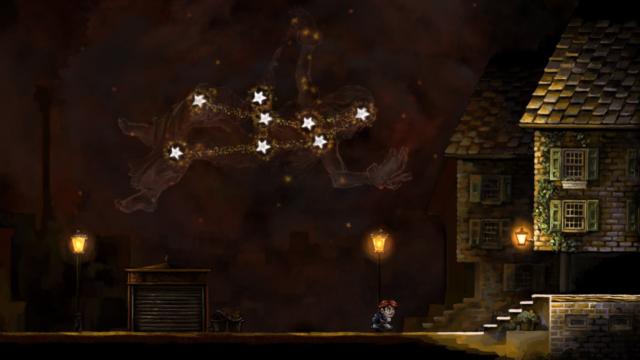
So, if you've done a little reading around, you might know that 'teh princess is a nuclear bomb and also Andromeda lololol' etc. What you might not have grasped is the significance of the second half of that, the Greek mythology. Yes, Andromeda is the 'chained maiden' (get it? Chained? Hahaha like chain-reaction amirite? WOOO!) in Greek mythology, who (if you collect all the hidden stars in the game) shows up in her own constellation in the beginning section of the game. And in fact the chain around her waist morphs into a braid. And yes, Jonathan Blow (the author of Braid) has said one of his influences was a game called 'Trinity', about the first atomic explosions, which used Greek god names for the different sections. But is there else something underlying this?
There's a reason the game apes Super Mario (and occasionally other early hero-and-princess games like Donkey Kong) memes - it's the last in a long line of hero myths, stemming back to the proto-myths of Andromeda and Perseus - one of the first known myths of a princess getting rescued by a hero-prince from a 'horrible monster'. That myth has a lineage that runs into the King Arthur myths (Sir Lancelot etc), and eventually runs into Super Mario Brothers.

I'm sorry, your princess is in another castle. Who is Bowser?
But at a deeper level it shows the persistence of the hero myth - the idea that a man can, with strength of will and courage, right wrongs, make the world a better place and (as a result) rescue the princess as his reward. This myth is prevalent in video games in one form or another, moreso than most media. Whether it's a feisty vixen rather than a princess, or an arrogant loner rather than a prince, the same 'make the day, get the girl' mentality really infests things here. Is Blow making a comment on the validity of that myth? Let's consider.
The game is structured like a dream - the logic, the cross-pollination and crossing-over of the character's female relationships (mother, lover, mistress, physics-symbolised-as-a-princess), the non-linear nature of time-and-place- all of these reference the dreamworld - where you can comfortably accept that your best friend has just turned into your housecat, because a reality-checking aspect of your brain is switched to off-position. Leedzie has a very good breakdown of the dream/relationship angle, including many amazing things missed in this article, here.
The hint is given in fact, in the final level of the game, where you chase the princess back to her house - the mailbox number, as many have noted, is the same as the house in the film Mulholland Drive - a film Blow is a big fan of. The director of Mulholland refuses to give any specific interpretation of the film, says there is a particular interpretation that he meant when making it, but that he is more than happy for people to draw their own responses from it - now why does that sound familiar?
"You can't stop people from having their own interpretation, that's a fact of the universe that we live in. So it would be foolish as an artist to try and dictate people's readings. It's counter to reality. At the same time, you have a reading that you intend, and I think that the more complex what you're doing is, you have some idea in your head about how much people are going to get." - Jonathan Blow
Moreover, the conclusion that most have come to on Mulholland drive is that it's a largely a sequence of dreams which the lead protagonist is having (see here for more details). This could be a subtle hint by Blow. But regardless, the rest of the scheme fits.
If you look at the nautical flags at the end of each level, they (as many have pointed out) say, from level 6 back to level 2, in increasing seriousness of urgency:
K - I have something to tell you
X - Stop carrying out your intentions and watch for my signals
L - Stop immediately
U - You are running into danger
N - No
As the game has no linear time-angle, but says at the start that the protagonist is 'going back to make things right', and the final level you play is level 1, there's a suggestion that you are traveling (in your own mind) back through your past to find something, that your subconscious does not want you to find out, because it will threaten the (dream)world. And when you do complete the final level, the epilogue shows a world completely disrupted, with elements from the previous levels floating or jutting out haphazardly with no real structure. But what exactly did the protagonist realize?
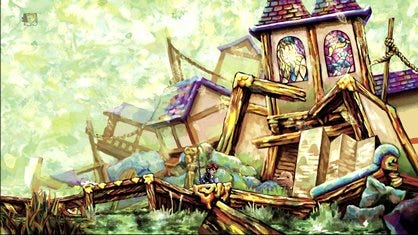
I realized my house got all F-ed up
The game was released on August 6th, the anniversary of the dropping of the first atomic bomb on Hiroshima. At the end of World War 2, there was an arms race to try and develop the world's first nuclear bomb before the Germans did - but in fact, the Germans had given up their nuclear weapons research many years earlier. However, lacking that knowledge, the Los Alamos team put all of their effort into developing the atomic bomb, naming the first test site 'Trinity' (get it? Trinity - three - Braids are made of, you guessed it, three strands of hair. WOOO! Yeah). There was a genuine feeling of urgency and danger, as they knew how dangerous the first bomb would be, how decisive it could be in a war. However, when they were finally able to deploy the nuclear weapon, largely unknown to the scientists, the war was already won - the Germans were defeated and the Japanese were only days away from surrender (in peace talks with the Russians and being destroyed by aerial fire-bombing from the Americans). In essence the bomb was dropped on an already-defeated enemy, and the scientists at Los Alamos, while initially jubilant, eventually came to realize they'd been involved in something horrific and unnecessary.
Blow addressed this slightly in an interview once, saying that people had mistaken the game text of [the princess has been] snatched by a horrible and evil monster for bad writing, in that the use of two similar words was superfluous his point was, that something can be horrible, but not evil, and vice-versa. This is the question historians are often faced with: using the bomb on Japan Was horrible, without a doubt - but was it evil? Did it save more lives than the alternatives? And this is also the question that the researchers at Los Alamos had to live with for the rest of their lives.
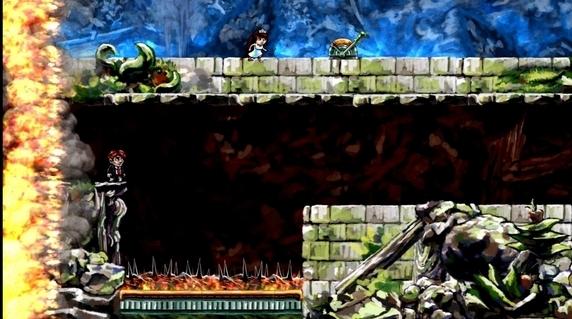
Oh girl come on don't be like that
In the last active level of the game there is a feeling of encroaching danger, of urgency as represented by the great wall of fire behind you - and it looks like the princess is helping you - but of course, if you complete the level, time reverses (to go forward instead of backward) and you realize that the princess was trying to escape from you - and that you, in fact, were the 'horrible and evil monster', not the hero. This is what disrupts the dreamworld and resolves the drama inherent in the games premise. You find out what your subconscious was trying to prevent you from realizing, by completing a series of tasks, fighting against the wards within your own head.
˜On that moment hung eternity. Time stood still. Space contracted to a pinpoint. It was as though the earth had opened and the skies split. One felt as though he had been privileged to witness the Birth of the World..." Braid, Epilogue, quoting William Laurence, the only journalist allowed at Trinity
And of course, we know from the epilogue text (which references multiple statements made at the trinity test site after the bomb was successful) - and from the fact that the princess is depicted in rainbow colours (light spectra) - and by the fact that she explodes massively if you manage to touch her (after you collect the 8 hidden stars and do certain things) - that the princess is an encoded reference to the atomic bomb.
So now we know there's an atomic angle. Who is Tim?
There's one Greek god asides than Andromeda who was chained to a rock, and that is Prometheus - chained by Zeus after attempting to steal fire from the gods (and forced to have his intestine picked out by crows for all eternity). Prometheus was referenced a Lot during the Los Alamos days, having even named an element of the periodic table after him (Promethium), as they were very conscious of their 'stealing fire', and of the potential punishment for doing so - the dangers it would harbour. However, one man came to be associated with the name so clearly, that in 2006 (the same year Blow started work on Braid, incidentally) a book was published about him - 'American Prometheus: The Triumph and Tragedy of J. Robert Oppenheimer'. It became a very well-known book and won a Pulitzer prize for its work, and it is unlikely that Blow did Not read it, as some of the in-game symbolism is reflected in it.
J. Robert Oppenheimer was the lead on the Trinity project, it's most well-known figure, and the program's most well-known victim in later years. He initially fully was convinced of the necessary nature of the bomb, and of their heroism in creating it, but later came to suffer from the knowledge of what he and others had done, and the responsibility of that great weight, leading him to declare later that "the physicists have known sin, and this is a knowledge which they cannot lose". Oppenheimer was however, initially a fan of the hero myth, particularly of that depicted in the ancient Hindu text the Bhagavad Gita. Two days before the explosion at Trinity, he recited the following to a friend:
"That evening, in an effort to relieve the tension, Oppie recited for Bush a stanza from the Gita that he had translated from the Sanskrit:
'In battle, in forest, at the precipice in the mountains
On the dark great sea, in the midst of javelins and arrows,
In sleep, in confusion, in the depths of shame,
The good deeds a man has done before defend him.'" - American Prometheus, pg 305
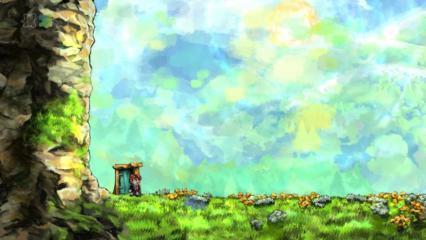
Man, you just making this all too Obvious.
Many years later, he would famously declare:
˜We knew the world would not be the same. Few people laughed, few people cried, most people were silent. I remembered the line from the Hindu scripture, the Bhagavad-Gita. Vishnu is trying to persuade the Prince that he should do his duty and to impress him takes on his multi-armed form and says, "Now I am become Death, the destroyer of worlds." I suppose we all thought that, one way or another.' - The Decision to drop the bomb 1965 (http://www.youtube.com/watch?v=26YLehuMydo)
Interestingly, the game also uses the hindu image of the lotus flower opening (or closing, depending on your time-perspective) repeatedly. In Hinduism (which the Bhagavad Vita is from) the opening of a lotus is meant to symbolize enlightenment.
So, Tim isn't Oppenheimer, he's a fictional character. Although the in-game depiction of Tim vaguely resembles a childlike version of Oppenheimer (the hollow cheeks, the thin face and nose) the paintings show him as many different boys with different coloured hair. And though the text almost explicitly calls on symbolism from Oppenheimer's life, it also deliberately calls in aspects which at the very least, cannot be verifiably tied to him. One of these is the fact that the Princess's bedroom at the end of the last active level contains soft-toy versions of the various creatures you meet in the game, in a suggestion that the protagonist's mind has unconsciously created rivals out of these objects of affection, perhaps from real-life memories of a girlfriend's bedroom.
It's as if the author wants to create a character who could've been anyone on the Los Alamos (Manhattan) project. Certainly, there would be some scientists who would match similar descriptions to Oppenheimer, in terms of his way of thinking and his background - Oppenheimer is simply the one we know the most about, who has been the most heavily documented, for various reasons. But I can say with some certainty that that character is heavily based upon Oppenheimer, his personality, his life, his relationships, triumphs and failings. Here are some examples of the things that match between Oppenheimer and Tim.
"If (Jean) Tatlock looked like an Irish princess, (Kitty) Puening sometimes claimed to be the real thing, only of German royalty." - American Prometheus
Jean Tatlock was Oppenheimer's first true love, but the relationship failed, with Jean leaving in anger. Later he married Kitty Puening, only to cheat on her occasionally with Jean, for whom he still had much affection. However, during the Manhattan project, with his whole family prevented from going outside of Los Alamos due to security concerns, he had to leave Jean alone and she grew depressed. Eventually she committed suicide, two months before the naming of the Trinity test site, which was named after one of John Donne's poems, which Jean had introduced him to.
"She never understood the impulses that drove him, never quite felt the intensity that, over time, chiselled lines into his face. She never quite felt close enough to him - but he held her as though she were, whispered into her ear words that only a soul mate should receive. Over the remnants of dinner, they both knew the time had come. He would have said: 'I have to go find the Princess,' but he didn't need to. Giving a final kiss, hoisting a travel bag to his shoulder, he walked out the door. Through all the nights that followed, she still loved him as though he had stayed, to comfort her and protect her, Princess be damned." - Braid, world 5
In the game, the princess is a blend of female archetypes, but predominantly refers to physics or the atomic bomb. In Oppenheimer's life, it was not much different.
"I need physics more than I need friends." - Oppenheimer, as a University student
"[his father] encouraged his son in this solitary hobby, plying him with books on the subject. Long afterward, Robert recounted that he had no interest in the geological origins of his rocks, but was fascinated by the structure of crystals and polarised light." - American Prometheus, pg 14
Oppenheimer was fascinated by physics at a young age, and his relationship to it was probably the primary relationship in his life, overshadowing his personal relationships. His fascination with the atomic bomb was almost a fascination with building a utopia - he sincerely believed that building a nuclear bomb would prevent the possibility of future global war by creating a threat so total that the mere application of it was unthinkable. But in the game it is almost depicted as the awakening of a terrible god, an empty, black utopia:
"She stood tall and majestic. She radiated fury. She shouted: "Who has disturbed me?" But then, anger expelled, she felt the sadness beneath; she let her breath fall softly, like a sigh, like ashes floating gently on the wind. She couldn't understand why he chose to flirt so closely with the death of the world." - Braid, Epilogue hidden text
This has a parallel - at least textually - in American Prometheus:
"Invariably, Ella found herself standing at the window of their Bay Shore home, searching for a trace of the Trimethy of the skyline... Robert, however, was unabashed; indeed he never failed to display absolute confidence in his mastery over wind and sea... He had an irresistible urge to flirt with danger." - American Prometheus, pg 24
But the fact is that Oppenheimer and most physicists saw their world largely in hypothetical terms:
"When you see something that is technically sweet, you go ahead and do it and you argue about what to do about it only after you have had your technical success. That is the way it was with the atomic bomb." Oppenheimer, discussing Los Alamos
The humanitarian issues raised by their development were almost wholy overshadowed by the inward-focussed technical, external questions raised in its inception.
˜"He worked his ruler and his compass. He inferred. He deduced. He scrutinized the fall of an apple, the twisting of metal orbs hanging from a thread. He was searching for the Princess, and he would not stop until he found her, for he was hungry. He cut rats into pieces to examine their brains, implanted tungsten posts into the skulls of water-starved monkeys.
Ghostly, she stood in front of him and looked into his eyes. "I am here," she said. "I am here. I want to touch you." She pleaded: "Look at me!" But he would not see her; he only knew how to look at the outside of things.“ Braid, Epilogue
Here, the female archetype appears to be that of ones sense of humanity. Perhaps Blow is pointing out that a real utopia cannot be created out of atoms, but out of a sense of one's own compassion and humanity that it is there, should you chose to look.
˜She picked him up and hugged him: "No, baby," she said. He was shaking. She followed his gaze toward treats sitting on pillows behind the glass: the chocolate bar and the magnetic monopole, the It-From-Bit and the Ethical Calculus; and so many other things, deeper inside. "Maybe when you're older, baby," she whispered, setting him back on his feet and leading him home, "Maybe when you're older." Braid, Epilogue hidden text
The cross-pollination of mother/mistress/lover/atom-bomb archetypes is a curious one, and I suspect also has a lot to do with the hunt for utopia - the concept of probably extends from - in some Freudian and primordial way - the absolute security of early (parental) relationships, which people then seek to recreate in their later lives, with lovers, or in the world at large.
But to be wedded to the idea of a utopia - or a utopic perception of a given individual - is a terrible thing - if not for you, then for the external person/reality.
"It was as if he had been called upon to act out a stage role, one to which he was truly not suited. Scientists are not meant to be conquering Generals. And yet, he was only human and so must have felt the thrill of pure success; he had grabbed a metaphorical gold ring and he was happily waving it aloft. Besides, the audience expected him to appear flushed and triumphant. But the moment was short-lived." - American Prometheus, pg 316, depicting Oppenheimer's addressing of Los Alamos scientists after the successful bombing of Hiroshima.
The ring can represent, as detailed above, being wedded to an ideal - an ideal of a person, or in the case of Oppenheimer and the game, the idea of having won. The idea having of creating a better, safer world.
"Tim wants, like nothing else, to find the Princess, to know her at last. For Tim this would be momentous, sparking an intense light that embraces the world, a light that reveals the secrets long kept from us, that illuminates - or materializes! - a final palace where we can exist in peace." Braid, World 1
In reality, there is no such thing as 'winning', in an objective long-term sense, which both Tim and Oppenheimer seem to eventually realize. In the game this deluded commitment to a nuclear-protected future is depicted, secretly but explicitly, in the game painting for that same world (World 6, "Resistance").

Here we can see, not only the ring in the picture, but that looked at correctly, at the angle of the bin below it, the ring also appears as the fiery ring of a nuclear mushroom cloud in the midst of a rocky mountain-scape. So Blow is - perhaps - using the ring as a crossed metaphor for a (flawed) commitment to the ideal of an atomic-caused utopia, and commitment to the ideal of the ideal individual (the princess, who has her own crossed metaphor as described above). Just to jump back a bit, we can see how this crossing over of metaphors fits well within the circumference of a dream, where this sort of blending of related concepts occurs naturally and without thought.
However, most likely the ring symbolizes the culmination of knowledge. Foreshadowing this in World 4 of the game, the levels have child's playing blocks in the landscape, some with letters, some with obscure symbols of scientific knowledge like the Epitaph of Stevinus:
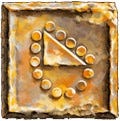
What is less noticeable is that the music in the game slows down around these blocks, indicating the kind of temporal gravity effect shown by the ring item in World 6. It is easy to miss, since the music only plays when you move, in these levels. But the effect radiates outwards in a circle from the blocks - you can prove this for yourself by passing one of them at a higher vertical point: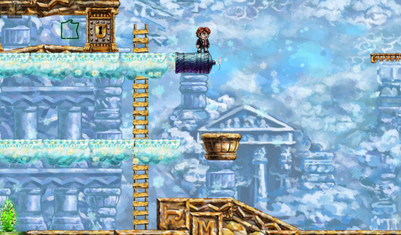
Here, the music will play normally. But if passed here:

The music will slow down (note: in order to do the lower path you must go in reverse, otherwise the ladder gets in the way of the flow of music). This is not a one-off effect - it occurs almost everywhere in World 4:
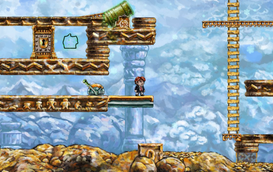
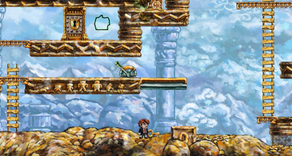
Normal music Slow music
Nowhere is this more noticeable than at the end of World 4, with the giant block containing the Aleph-one symbol, the infinite set of all ordinal numbers:
So, perhaps with this culmination of knowledge, the 'ring' is forged in World 6, replete with the implications of atomic knowledge (that time slows down infinitely as objects reach the speed of light). Either way there seems to be a progression of the accumulation of knowledge in World 4, and we see it's consequences later.
"Perhaps in a perfect world, the ring would be a symbol of happiness. It's a sign of ceaseless devotion: even if he will never find the Princess, he will always be trying. He still will wear the ring." - Braid, world 6

It's up to you, New York, New Yoooooooork!
Also in World 6, we come across a level where the city of Manhattan is just beginning to burn. This is interesting, because it shows a transition between World 1, where Manhattan is fine, and clearly shows time moving forward to reach World 6, where a nuclear bomb is just going off, to the first screen of the game, where Manhattan is in flames. Oppenheimer himself clearly pointed out the danger of this to others:
'A major war was not Oppie's only worry; he was concerned too about nuclear terrorism. Asked in a closed Senate hearing room "whether three or four men couldn't smuggle units of an [atomic] bomb into New York and blow up the whole city." Oppenheimer responded, "Of course it could be done, and people could destroy New York." When a startled senator then followed by asking, "What instrument would you use to detect an atomic bomb hidden somewhere in the city?" Oppenheimer quipped, "A screwdriver [to open each and every crate or suitcase]." There was no defense against nuclear terrorism - and he felt there never would be.' - American Prometheus, pg 349
Manhattan is not merely a reference to the Manhattan (Los Alamos) project. Manhattan is also both the place Oppenheimer grew up, and where Tim grows up. Both were exposed to arts and literature (as is Blow), as Oppenheimer's father was a wealthy man and had many Picasso paintings. If we take as writ that the game is a dream, then it makes sense that those same influences are showing up in the dream in the form of the landscape, the music, the paintings. The irony that Blow is perhaps seeking to point out, is that whether or not the goal (the princess) is reached, Manhattan still ends up in flames. The pursuit of the utopia - and the detail, cunning, and heavy thinking that this involves - is depicted as having no real-world effect. Is this a critique of the hero myth, and by extension, a critique of games and the energy we put into them? Only Blow knows. But it certainly depicts the hero and princess archetypes as empty:
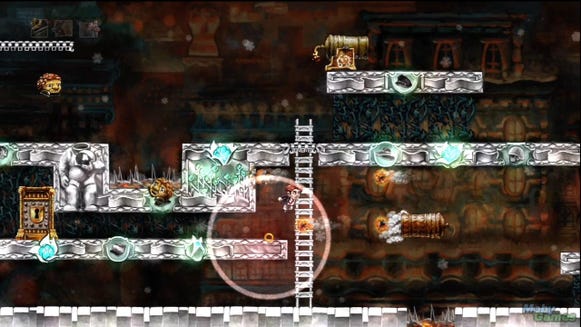
That damn astronaut's no good under pressure - he's lost his head!
On the same level, all of the backgrounds are dotted with the hats and uniforms of cowboys, indians, firemen, astronauts - the calling cards of hero roles. All of the hats and uniforms are empty. At the end of the level, there is a building with a statue of a small child looking out in wonder at all of this, suggesting the early imprinting of the idea of the heroics invested in these activities, whilst not truly comprehending their inherent emptiness.
Likewise, the princess is depicted in a wedding dress (keeping in sync with the 'ring' theme of the world) but, likewise, her head is hidden and dark. Above her and around her an artful depiction of the atomic bomb exploding/tree-in-a-pot is shown, stemming from her, as snowflakes fall.

So, Braid is a game about - a dream - which is being had by - Tim, a fictional character heavily based upon the life of J Robert Oppenheimer, father of the atomic bomb - about his past, which he spent in the pursuit of ideals - be that the ideal relationship, or the ideal of a utopic world. The game, via its text and logic, critiques this pursuit, and the hero-princess roles that accompany it - depicting them both as empty, lacking in substance, and ultimately dangerous - or futile? - to pursue. The only happiness or positive end-result is a complete dismantling of the hero's conception of himself, of heroes, of princesses, leaving him to build his own conception of his life and identity, free of the misconceptions of his past. Blow secretly invites us to do the same.
Is it an anti-game? If it were, Jonathan Blow wouldn't be making more games - clearly he believes us, the games audience, as capable of the kind of thought, substance, and wit that other games designers believe are non-existent. He may've been overreaching though. He initially expressed disappointment at the lack of understanding of Braid by both games journalists and the public at large, while later acknowledging that it is a very interpretable game. Was his goal worth it?
And it is an interpretable game. If anyone has a firm, concrete critique of my exam here, and has objective evidence to back it up, feel free to contact me.
But I feel the point of the game is not so much what Braid is meant to be objectively, it's what it is subjectively to the individual. I had my own deep, emotive response to the game, that had nothing in particular to do with the content - this is the advantage of spanning your metaphors so vast that they can envelope entire subjects - like lyrics, they can end up meaning something personal to each and every individual that hears them. What's your interpretation? And is that really as important as what your unconscious emotional response to the game was? That's the beauty of high art. And that's what Braid is.
[UPDATE 8/18: Though I have some reservations about the zeal & certainty with which I wrote the above, I still feel some of it holds true. Particularly the bits about the hero myth. Also I've updated the article with discovery in World 4. But I just thought I'd share one last thing. In the midst of the 'Hunt' levels, there are individual pictograms at the top for each of the enemies you kill, while the enemies themselves all look the same. Perhaps there is a point to be made here, since Blow has made it clear in an interview that this was important and intentional. Rather than dismiss the beings you destroy in service of your goals as being 'all the same' - as a soldier would with enemy combatants, or a scientist might with lab rats - one might gain greater understanding, and humanity, by seeing the beings as unique individuals, and perhaps nearer to a greater goal than the quest you are on. Perhaps I am reading too much into things :)]
Read more about:
BlogsYou May Also Like